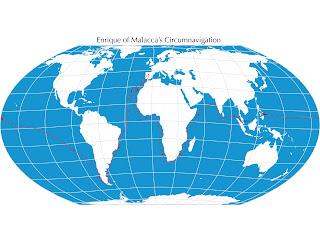 |
| The Santiago's final journey, and the ground the crew hiked to survive. |
The
The Crew
The Santiago carried 14 crew members from Castile as well as crew members from France (6–7), Genoa (4), Flanders (2), and the Azores (1). In addition to able seamen and apprentice seamen, the Santiago carried a caulker, a carpenter, a clerk, two gunners, a sergeant-at-arms, and two cabin boys.
Most notable aboard the Santiago was its captain, Juan Rodríguez Serrano (João Rodrigues Serrão in Portuguese). Historians have long assumed Serrano was Portuguese, possibly the brother of Francisco Serrão, Magellan’s close friend, who had reached the Spice Islands from Malacca a decade earlier.
Juan Rodríguez Serrano
Serrano had sailed aboard Spanish ships since his youth and had crossed the Atlantic to the coast of Brazil once before, in 1499–1500. A royal pilot, he served aboard the Santiago as captain and pilot. Serrano remained loyal to Magellan throughout the voyage.
When the fleet wintered at Puerto San Julian in Patagonia, the Santiago was the first ship to be reconditioned. Anxious to get the expedition moving, Magellan sent the Santiago ahead to scout the coast, to seek either a strait or a cape—or at least a better place to replenish supplies.
The Santiago left Puerto San Julian around May 1, and on May 6 found an estuary full of seals and penguins. Serrano named the estuary Santa Cruz. The Santiago remained there for two weeks, the crew slaughtering and roasting seals.
Shipwreck and Rescue
Shortly after departing on May 22, the Santiago was hit by a fierce storm. Winds tore away its sails and a large wave washed away its rudder. The Santiago was left floating helplessly, the winds driving it toward shore.
Here, Serrano’s experience came to the rescue. The royal pilot managed to hoist a spare sail and—with no rudder—steer the ship bow first toward a beach. Hitting rocks would have meant disaster, yet Serrano brought the Santiago to rest close enough to sand that all but one crew member were able to jump to safety.
Minutes later the Santiago broke up in the waves.
The Santiago’s crew were now stranded far beyond the end of the map, in winter conditions and with little food. Making matters more uncomfortable, they knew the map ended where it did because a landing party from the previous expedition down the coast was attacked and eaten by cannibals. On a beach with crew looking on from offshore.
With this thought in mind the group of 30 men hiked over rough terrain for four days to get back to the estuary. There they sent two young crewmen on, for a trek that took nearly two weeks before the two reached Puerto San Julian, where the fleet waited.
Magellan decided to send a rescue party of 20 men on foot—loaded with bread and wine for the Santiago’s shipwrecked crew. It was June 26 before the rescue party arrived at Santa Cruz, some five weeks since the ill-fated Santiago's shipwreck.
Magellan reassigned Serrano as captain of the Concepción, whose original captain, Gasper de Quesada, was executed following the Easter mutiny.
Later when Magellan was killed at Mactan, Serrano was chosen along with Duarte Barbosa to take command of the fleet. Barbosa, likely Magellan’s brother-in-law, was killed days later at the massacre at Cebu. Serrano was last seen just after, beaten and dragged to the beach.
Under the command of João de Lopes Carvalho, the three remaining Spanish ships fled, abandoning Serrano. His fate is unknown.
By John Sailors
(C) 2022, by John Sailors.
Was Enrique of Malacca Filipino?
Enrique of Malacca's origin is a subject of debate. Three places are considered possible: Malacca, then a major trade hub on the Malay Peninsula; Sumatra, the large island adjacent to Malacca; and the Visayan Islands in the (modern-day) Philippines. The evidence points to Malacca, though chronicler Antonio Pigafetta said Sumatra, and some scholars believe it's possibly Enrique was from the Visayan Islands in the modern-day Philippines? See the historical evidence in this post: Where was Enrique of Malacca from, Malacca or the Philippines?
- EnriqueOfMalacca.com
- Enrique of Malacca on Twitter
- Enrique of Malacca on Facebook
- John Sailors / Enrique on Medium
- And, yes, Enrique might be 500 years old, but he was known as a kid, so of course he's now on Instagram too.


